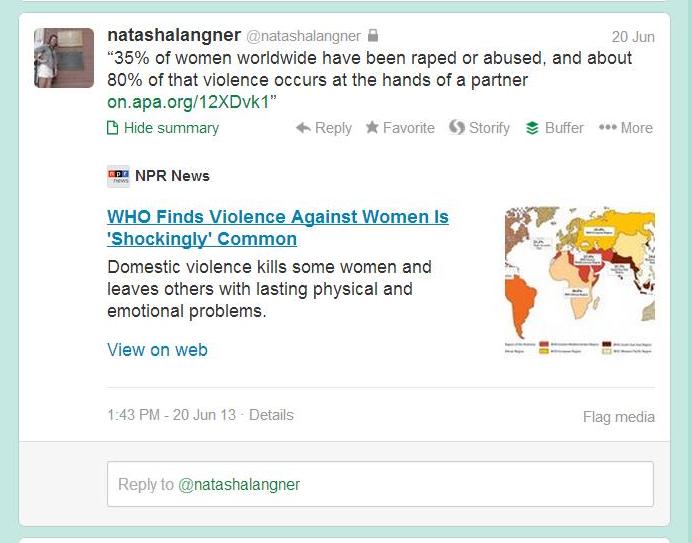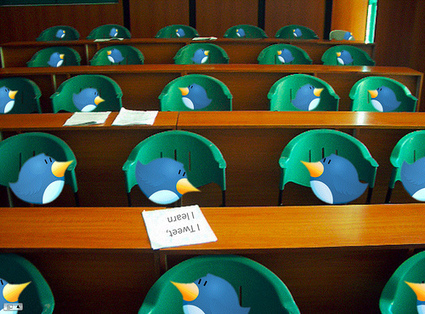Using Storify in the Classroom: A Student’s Perspective from Natalie Savoy
Back in January, Dr. Jamie Mitchell from Wayne State University wrote about an assignment for her Human Behavior in the Social Environment Theory class that incorporated Storify, a social media platform that allows users to curate a digital narrative about any topic. The assignment required students to articulate how a theory of their choosing could be applied to a real-world, under-served population or problem of interest using Storify. As a follow-up to Dr. Mitchell’s post, I asked one her MSW students, Natalie Savoy, to share her thoughts on the assignment, what it was like to use social media in the classroom and how social media might be incorporated in her future role as a social worker. Here are Natalie’s responses to my questions:
What was your initial reaction to using social media for an assignment in your Human Behavior in the Social Environment Theory course?
Twitter: The Educational Commons By Justin Vest
Justin Vest graduated with his BSW from the University of Montevallo in December 2013 and begins the MSW program at the University of Alabama in January 2014. In this post, he discusses how his use of Twitter grew from a class assignment to a professional tool.
Twitter can be about celebrities and national or global trends, but I find its value in connecting users with educational content. I was first introduced to Twitter as an educational tool in Spring 2013 while taking Dr. Laurel Hitchcock’s class on social work with groups, communities, and organizations. The assignment encouraged students to engage with social media as a means of discovering information and connecting with other professionals. Over a relatively short period of time I have modified my own Twitter usage from that of fulfilling a course requirement to actively utilizing it as a tool for continuous learning. Above all else, I feel my role in the Twitter-sphere is that of student. I have a wide array of interests (mostly professional) that I keep up with via Twitter to the point that it is one of my primary sources for information regarding specific topics. To do this, I have created lists reflecting professional interests and categorized most of the people and organizations I follow into one of them. I am then able to filter out everything in my feed except tweets from pages within a specific list. Other Twitter users can also choose to follow these lists.
As a social networking site, Twitter can also be a valuable tool for networking with other professionals. While I don’t personally generate a lot of interactive content, I have found it to be very useful in connecting with other social workers who share my own interests in macro practice, particularly in areas of policy. Given the limited emphasis on macro practice within social work education, it is nice to be able to follow the work and thoughts of social workers employed in the macro arena. Several great resources that I’ve seen come from Rachel L. West including this one on how to search for macro job listings and this one on using social media to establish a career in macro social work. Others of note include:
- Melinda Lewis (@melindaklewis), author of Classroom to Capitol blog
- Congressional Social Work Caucus (@SocWorkCaucus)
- Congressional Research Institute for Social Work and Policy (@CRISPontheHill)
Perhaps the thing I find most fascinating about Twitter is its ability to give a voice to people who may not otherwise have the means to express their thoughts, feelings, and opinions. Twitter and other social media sites were credited, at least partially, with many of the successes of the Arab Spring. It was paramount to Occupy Wall Street organizers’ ability to call supporters to action at a moment’s notice and it provided a venue for many to express their frustration and educate others about issues of systemic racism in the U.S. after the verdict in the Trayvon Martin murder trial. Most of the pages I follow provide information that is not readily available via mainstream media sources and it is a great benefit to essentially use Twitter lists as a RSS feed pertaining to topics I want to learn more about.
One of my constant struggles with Twitter is determining what to share. The vast majority of my tweets contain links to outside sources, typically with the intent to inform others of something I believe is important or otherwise of note. Many things translate simply into an obvious category of professional interest like tweeting against cuts to the Supplemental Nutrition Assistance Program (SNAP) in order to prevent reduced access to food for low-income households. Other topics do not fall neatly into the purview of social work and may be more prone to divisiveness. My main concern with these topics (think partisan politics) is how it will appear to a potential employer, so I attempt to convey an educational message while not necessarily endorsing the content. I do also plan to get in the routine of blogging about policy issues from a social work perspective over the winter break as means of both exploring in greater depth some political ideas as well as highlighting my professional values and skills to potential employers.
How to cite this post:
Vest, Justin. (2013, December 9). Twitter: The Educational Commons By Justin Vest [Blog Post]. Retrieved from https://laureliversonhitchcock.org/2013/12/09/twitter-the-educational-commons/.
Tweeting Is Not Just For The Birds… By Natasha Langner
 Natasha Langner is an undergraduate social work and psychology major at the University of Montevallo. In this post, she discusses what she learned from using Twitter during an internship at the Washington Center in 2013.
Natasha Langner is an undergraduate social work and psychology major at the University of Montevallo. In this post, she discusses what she learned from using Twitter during an internship at the Washington Center in 2013.
During the summer, I had the pleasure of studying in DC through The Washington Center for Internships and Academic Seminars interning with Becky’s Fund, which is a non-profit organization working towards assisting victims of domestic violence as well as bringing awareness to the issue in the community through various programs and through the social networks such as Twitter and Facebook.
My first assignment with the organization was to find five interesting articles dealing with domestic violence. I had to read, analyze, summarize the content, and then use the summarized content to come up with an engaging sentence that will attract the readers to click on the Twitter link. This is actually harder to do than it seems, especially since I never used Twitter in a professional setting before that assignment.
One of the most important things I had to keep in mind as I used Twitter was the fact that whatever piece of news I decided to share with the online community, I had to make sure that it was thought-provoking and that the audience learned something. Because of the vast amount of information that Twitter generates, I had to make sure that my Tweets stood out, which requires creativity and an analysis of the articles that I shared.
My strategy for using Twitter is asking many, many different questions. Whenever I read a news article, I ask myself why the information is important to me, and why should the public care about this information. If you cannot come up with an answer to both of those questions then you should probably find something else to Tweet. Next, I create a question that is directed towards my audience, whether asking for their opinion on the issue at hand (because everyone loves to give their opinions), or asking the viewers to think about how this issue affects them personally and what they can do about it.
The greatest advantage of utilizing Twitter as a student is the networking aspect. When I was in DC, we were constantly reminded to network with other interns as well as professionals in the city. When we engaged in networking events, Twitter was the most popular form of communication and connection among the people after the initial meeting. Twitter allows students to connect with other professionals and it exposes us to an abundant amount of resources from all over the world. When I met people in high positions they did not say, “Here’s my e-mail if you need anything”, but they did say, “Follow me on Twitter, or Let’s connect on Twitter”.
For future professionals, Twitter allows us to build our “work samples” in the areas that we are passionate about. Employees will look at your online profile before they will look at your resume or before they decide to hire you. Twitter allows them to see your involvement in the issues that are important to the organization or the company that you are hoping to work for one day. Having a strong Twitter account, meaning you use your Twitter for discussions of important issues, will enhance your image as a future professional because it tells others that you are keeping yourself informed in the current events as well as advocating on behalf of the issues by taking the time to inform the public.
My recommendations for using Twitter include:
– Find an organization or an issue that you are passionate about and follow them.
– Learn to summarize vital information in two good sentences and then learn how to use that information to engage the public. This practice will be valuable in other areas of your life.
– Be consistent with your account. Try to Tweet something important on a frequent basis. Do not make your followers wait a year until you make another Tweet.
– Be engaging and creative with your audience. If they do not see how an issue applies to them, they will probably ignore your Tweet.
-Finally, use Twitter as if someone’s life depended on it. If domestic violence is your issue, then make sure that each Tweet counts because you might literally save someone’s life with the information that you post.
Tweeting Is Not Just For The Birds… By Natasha Langner
How to cite this post:
Langner, N. (2013, November 5). Tweeting Is Not Just For The Birds… By Natasha Langner [Blog Post]. Retrieved from https://laureliversonhitchcock.org/2013/11/05/tweeting-is-not-just-for-the-birds-by-natasha-langner/.




